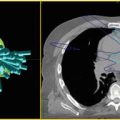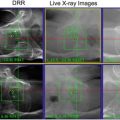(2.1)
In its simplest form, differences in tissue or tumor responses can be calculated using BED, the biologically effective dose, obtained from a fraction size of dose d delivered n times (Eq. 2.2). Average values of the α/β ratio are often taken as 3 (Gy3) for late reacting tissues, or 10 (Gy10) for acute responses, including most tumors:

(2.2)
The major issue is that the LQ formula describes a continuously bending dose-response curve (the βD2 component) whereas what is most commonly observed is a simple exponential response following an initial shouldered region. Thus using Eq. (2.2) to predict the BED of an SRS /SBRT treatment will potentially overestimate toxicity. A number of models have been proposed that counter this discrepancy. Of the many published models, the Universal Survival Curve (USC) of Park et al. offers a direct approach and grafts a multitarget dose-response model on to a standard LQ equation (Park et al. 2008). This has the benefit of better representing the biological reality of radiation lethality of simple survival curves, but does not address the many differences in clinical responses linked to SRS/SBRT that are discussed above. Many in the field are still divided on the issue, some suggesting that the LQ relationship is still valid, and others being less convinced (Park et al. 2008; Guerrero and Li 2004; Shibamoto et al. 2012). Sample calculations made using Eq. (2.2) illustrate the dramatic differences in calculated BED using the LQ formula for SRS/SBRT (Table 2.2). We would offer the following guidance: To generate an indication of the potency of a SRS/SRBT schedule compared to a conventional fractionation scheme, the LQ formula will provide appropriate estimates up to fractional doses in the range of 6–10 Gy. Above this, application of the LQ methodology will have reduced power to provide a comparison with conventional schedules. However, as in all applications of BED calculations, the result generated should only be considered as a guide. In the case of clinical questions related to normal tissue toxicity from SRS/SBRT schedules, empirically established dose limits and tolerances from relevant clinical literature should be respected for this increasingly used modality.
Table 2.1
Advantages and disadvantages of SRS /SBRT from a radiobiological perspective, organized according to the five “R” principles of radiobiology
Parameter | SRS/ SBRT disadvantage | SRS/ SBRT advantage |
|---|---|---|
Repair | Limits the number of cycles of damage and repair that separates the tumor response from normal tissue toxicity | Improved tumor targeting reduces the dose to normal tissues and the need for sparing by fractionation |
Reoxygenation | Fewer treatment cycles potentially reduces inter-fraction reoxygenation and thus increases radioresistance | None |
Repopulation | None | Much reduces or eliminates tumor repopulation during shorter treatment—specifically relevant to radiation resistant tumor stem cells |
Redistribution | Reduced numbers of fractions will affect the cell cycle distribution of remaining viable cells. Though redistribution could favor fractionated RT which provides a higher probability of catching cells in their vulnerable cell cycle states, the clinical significance is unknown | |
Radiosensitivity | None | Multi-log cell kill reduces the variability in tumor radiosensitivity primarily observed within the shoulder region of the cell survival curve. Single-tumor doses >10 Gy may trigger endothelial cell apoptosis |
Table 2.2




BED calculation
Stay updated, free articles. Join our Telegram channel

Full access? Get Clinical Tree





